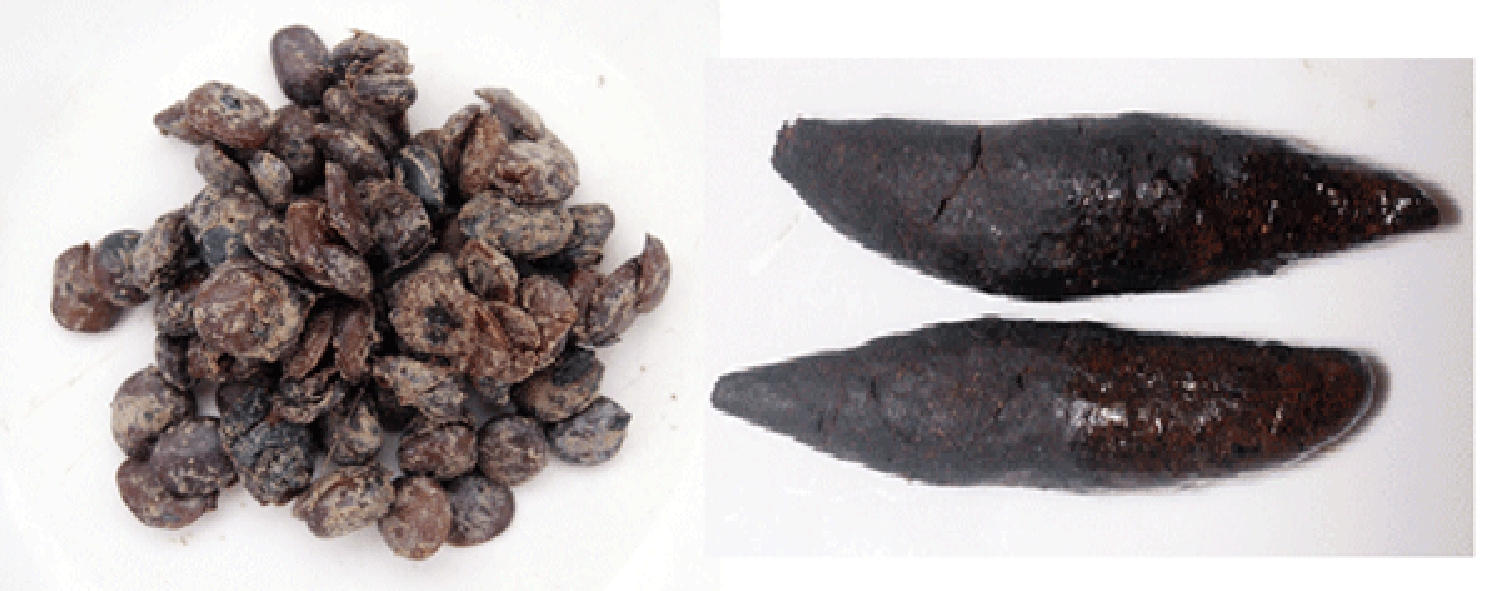FabulousFusionFood's Spice Guide for Njangsa Home Page
 Dried seeds and seed
paste of njangsa
Ricinodendron
heudelotii.
Dried seeds and seed
paste of njangsa
Ricinodendron
heudelotii.
Welcome to the summary page for FabulousFusionFood's Spice guide to Njangsa along with all the Njangsa containing recipes presented on this site, with 6 recipes in total.
This is a continuation of an entire series of pages that will, I hope, allow my visitors to better navigate this site. As well as displaying recipes by name, country and region of origin I am now planning a whole series of pages where recipes can be located by meal type and main ingredient. This page gives a listing of all the Cornish recipes added to this site.
These recipes, all contain as a major flavouring.
Njangsa (also known as Munguella (Angola), Essessang (Cameroon), Bofeko (Zaire), Wama (Ghana), Okhuen (Nigeria), Kishongo (Uganda), Djansang, Essang, Ezezang and Njasang) represents the dried seed kernels of the fruit of the Ricinodendron heudelotii tree, a member of the Euphorbiaceae (Spurge) family that's native to tropical West Africa from Guinea to Angola and eastward to Uganda and which typically grows in rainforests but likes disturbed ground. The tree itself is fast-growing and can reach up to 40m in height and 3m in girth. The leaves are alternate with sessile, glandular or denticulate leaflets. The flowers are typically bourne in Aril and May and are typically yellow with inflorescences up to 41cm long, with both male and female panicles. Thesee mature to indehiscent fruit that tare typically 2-3 lobed and contain 2 cells. The fruit themselves are thick, hard shell and a smell of overripe apples; contains 2-3 red-brown-black seeds, rounded, flat, over 1 cm across. Two varieties are recognized: R heudelotii var heudelotii in Ghana, and R heudelotii var africanum in Nigeria and westwards. The generic name is based on the Greek words for 'tick' and 'tree' because the seeds were thought to resemble ticks.
The seeds themselves are oily in texture and can be purchased either dried or in their natural oily state. In Senegal they are often pounded in a pestle and mortar before being dried in hand-rolled sausage (Image, right) shapes, whereas in Nigeria they pounded fruit are more typically pressed into disks (cakes) and dried before sale. These are then used to both flavour dry dishes and to add body to 'wetter' dishes such as stews. The aroma of the seeds are rather like oily chocolate but the flavour is very distinctive, subtly aromatic with a slight bitter aftertaste, which is why this spice makes an excellent addition to plain rice dishes. Dried Njangsa should be steamed or boiled before use, with the boiling water used subsequently to prepare rice. It can also be added as a flavouring to West African style 'soups'.
This is a continuation of an entire series of pages that will, I hope, allow my visitors to better navigate this site. As well as displaying recipes by name, country and region of origin I am now planning a whole series of pages where recipes can be located by meal type and main ingredient. This page gives a listing of all the Cornish recipes added to this site.
These recipes, all contain as a major flavouring.
Njangsa (also known as Munguella (Angola), Essessang (Cameroon), Bofeko (Zaire), Wama (Ghana), Okhuen (Nigeria), Kishongo (Uganda), Djansang, Essang, Ezezang and Njasang) represents the dried seed kernels of the fruit of the Ricinodendron heudelotii tree, a member of the Euphorbiaceae (Spurge) family that's native to tropical West Africa from Guinea to Angola and eastward to Uganda and which typically grows in rainforests but likes disturbed ground. The tree itself is fast-growing and can reach up to 40m in height and 3m in girth. The leaves are alternate with sessile, glandular or denticulate leaflets. The flowers are typically bourne in Aril and May and are typically yellow with inflorescences up to 41cm long, with both male and female panicles. Thesee mature to indehiscent fruit that tare typically 2-3 lobed and contain 2 cells. The fruit themselves are thick, hard shell and a smell of overripe apples; contains 2-3 red-brown-black seeds, rounded, flat, over 1 cm across. Two varieties are recognized: R heudelotii var heudelotii in Ghana, and R heudelotii var africanum in Nigeria and westwards. The generic name is based on the Greek words for 'tick' and 'tree' because the seeds were thought to resemble ticks.
The seeds themselves are oily in texture and can be purchased either dried or in their natural oily state. In Senegal they are often pounded in a pestle and mortar before being dried in hand-rolled sausage (Image, right) shapes, whereas in Nigeria they pounded fruit are more typically pressed into disks (cakes) and dried before sale. These are then used to both flavour dry dishes and to add body to 'wetter' dishes such as stews. The aroma of the seeds are rather like oily chocolate but the flavour is very distinctive, subtly aromatic with a slight bitter aftertaste, which is why this spice makes an excellent addition to plain rice dishes. Dried Njangsa should be steamed or boiled before use, with the boiling water used subsequently to prepare rice. It can also be added as a flavouring to West African style 'soups'.
The alphabetical list of all Njangsa recipes on this site follows, (limited to 100 recipes per page). There are 6 recipes in total:
Page 1 of 1
| Dawadawa Jollof Rice with Guinea Fowl Origin: Ghana | Mbongo Tjobi Origin: Cameroon | Ragoût Njansang (Njansang Stew) Origin: Central African Republic |
| Dry Rice and Fish Origin: Liberia | Ndolé à la Viande (Bitterleaf with Meat) Origin: Cameroon | West African Curry Powder Origin: West Africa |
Page 1 of 1